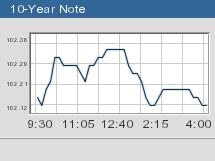NEW YORK (CNN/Money) -
A deceptively strong report on weekly jobless claims knocked the dollar to a three-month low versus the euro Thursday, after Wall Street took a moment to digest the report.

Treasuries, meanwhile, took little notice of the report.
The single European currency traded as high as $1.2406 earlier in the session before easing to $1.2387 by 4:45 p.m. ET. The euro bought $1.2369 late afternoon Wednesday. But the dollar traded higher against the yen at ¥108.98, up from ¥108.47 late Wednesday afternoon.
New applications for jobless benefits plunged to 310,000 in the week ended July 3, on a seasonally adjusted basis, compared to the revised 349,000 claims filed the previous week.
Economists, however, credit the decline in claims to a faulty seasonal adjustment formula rather than fewer layoffs.
"The euro's rise versus the dollar is a combination of three factors," Mike Malpede, senior foreign exchange analyst at Refco Group Ltd., told Reuters. "The jobs claims data, which was better than expected on the surface, was distorted by seasonal factors, so it doesn't give you any real insight into where the Fed policy is headed."
"We had a stronger-than-expected industrial production number from Germany, which is giving underlying support to the euro, and the third factor is the weakness in the equity market," Malpede added.
Much of the decline in the claims data was due to a seasonal adjustment, which anticipated the regular layoff of auto workers due to the closing of assembly plants that are preparing for the new model year. This year, many of those layoffs are more likely to occur in this week's data rather than last week's results.
The dollar has been hampered by the Federal Reserve's insistence on a measured pace for interest rate rises, weak June payrolls data and a report on Tuesday showing a slower pace of expansion in the U.S. service sector, analysts said.
In the bond market, Treasury prices drifted slightly higher in late afternoon trade with a fresh supply of government debt receiving a lukewarm reception.
The benchmark 10-year note gained 1/32 of a point in price to 102-5/32, to yield 4.47 percent, down from 4.48 late afternoon Wednesday. The 30-year bond was little changed at 102-4/32 with a 5.23 percent yield, unchanged from late Wednesday afternoon.
The two-year note picked up 1/32 of a point in price to 100-14/32 to yield 2.52 percent, and the five-year note advanced 4/32 of a point in price to 99-28/32 to yield 3.65 percent. Prices and yields move in opposite directions.
A $10 billion sale of new 10-year TIPS notes garnered a high yield of 2.02 percent and drew bids for 1.89 times the amount on offer -- just below the 2.08 average of the previous five sales. Bids, or bid-to-cover, refer to how much interest there is in a new issue compared with the amount being offered.

-- from staff and wire reports
|

